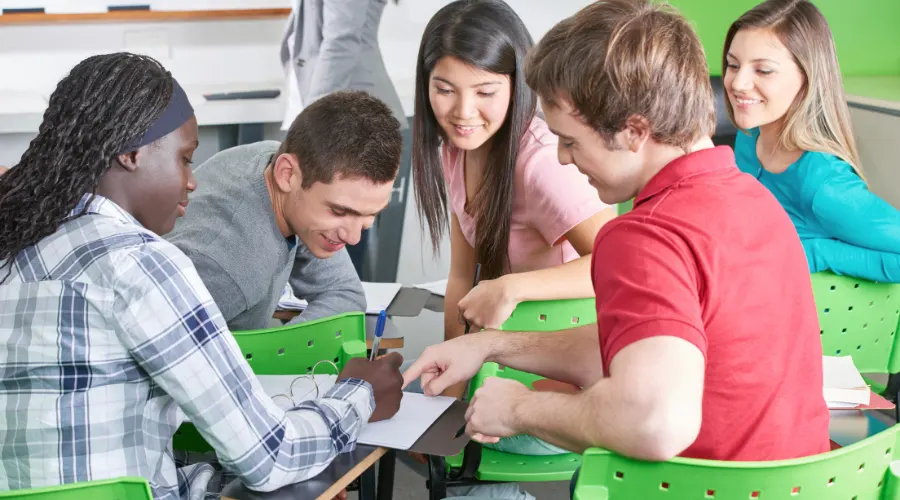Group work in the classroom is almost always fun for our students. Who doesn’t love working with friends, especially if they’re your favorite? However, simply working in groups isn’t enough. You need to know how to make it more effective to achieve results.
You and your team members need to set goals for the best output of your group work. If everyone gives their best, your team’s goals will be easily achieved. But it’s not that easy; you must follow some rules.
In this article, I will discuss the basic rules for effective group work in class, breaking them down simply so you can easily understand them. Let’s get started.
What Does Effective Group Work Mean?
You may be wondering what effective group work entails. It’s easy to forget practical matters when working in a group with friends. So, I want to talk about what effective group work means here.
Effective group work means working with classmates in a way that helps everyone learn and succeed. It involves listening to each other, sharing ideas, and supporting each other to reach a goal. When teamwork is effective, everyone feels included, valued, and motivated to do their best work.
Benefits of Group Work in the Classroom
Learning Together: In groups, we can learn from each other’s ideas and experiences, deepening our understanding of the topic.
Building Skills: Group work helps us develop important skills like communication, problem-solving, and teamwork, which are valuable for school and beyond.
Boosting Confidence: Working with others gives us confidence in our abilities and teaches us how to work well with different people.
Making Friends: Group work creates opportunities to make new friends and build strong relationships with classmates.
Having Fun: Group projects can be enjoyable and exciting, making learning more engaging and memorable.
Rules for Effective Group Work in the Classroom
Now let’s explore how effective group work can be achieved. You must read the following rules carefully and use them.
Rule 1: Listen and Respect Each Other
The first rule of group work is to listen to each other and treat everyone with respect. That means when someone is talking, you listen quietly and wait for your turn to speak. Everyone’s ideas are important, so make sure to listen carefully and be polite. Remember that this is often the reason why most group work fails.
Rule 2: Share and Take Turns
In a group, everyone should have a chance to share their ideas and opinions. Don’t hog the conversation or interrupt others when they’re speaking. Take turns talking and ensure everyone has a chance to contribute.
Rule 3: Stay on Task
When working in a group, it’s important to stay focused on the task at hand. Avoid getting distracted by talking about unrelated things or playing with your phone. Stay focused on the project and keep working until it’s done.
Rule 4: Help Each Other Out
Group work is all about teamwork, so be sure to help each other out whenever you can. If someone is struggling with a task, offer to lend a hand or explain things in a way they understand. Working together makes the difficult task easier for everyone.
Rule 5: Follow the Plan
Before you start working, make a plan for how you’re going to tackle the project. Decide who will do what and set deadlines for each task. Stick to the plan as much as possible and check in regularly to ensure you’re on track.
Rule 6: Be Flexible
It’s acceptable when things don’t always go as planned, and that’s okay! Be flexible and willing to adapt if things change or if someone needs help with a different task. Being able to adjust your approach is an important part of working in a group.
Rule 7: Celebrate Success
When you finish the project, take a moment to celebrate your success as a group. Acknowledge everyone’s hard work and the contributions they made to the project. Whether it’s with high-fives, fist bumps, or a round of applause, celebrate your achievements together!
FAQs:
To form a group in the classroom, consider students’ abilities, backgrounds, and personalities. Form diverse groups and assign roles and responsibilities based on each student’s strengths and interests.
An example of group work in a classroom is a group project where students work together to research a topic, create a presentation, and present their findings to the class.
An effective group learning experience in the classroom is characterized by active participation, collaboration, clear goals, shared responsibility, and open communication among group members.
Conclusion
Following these simple rules for effective group work can help make your classroom projects more successful and enjoyable for everyone involved.
By listening, sharing, focusing, and helping each other, you can work together as a team to achieve great things. So remember to follow the rules, stay positive, and have fun working with your classmates!
Suggested read:

